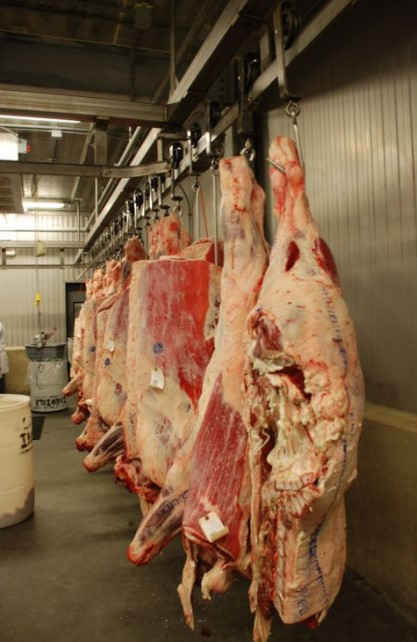By Kevin Gould and Jeannine Schweihofer
Management is key to finishing cattle at the proper time for small meat processing appointments.

In many cases, farmers are making harvest appointments 12-to-24 months in advance at small processors and cattle for these appointments may not have even been born or procured. This increases the importance of pairing proper cattle selection and nutritional management with careful planning to optimize direct marketing opportunities.
Communication and scheduling harvest appointments with the processor are critical and it is important to understand and follow the appropriate regulations. Sale procedures will be different depending on how beef is marketed. Selling the live animal is required when custom exempt processing is used. Slaughtering and processing at federally inspected processors allows for marketing of individual cuts or bundles of meat.
Selecting cattle that will achieve desired carcass quality, including marbling deposition and carcass weights in a timely manner will impact business profitability. Ask questions about the about health protocol, genetics or breed type, and what to expect if you are not familiar with a breed. The exact breed is not as important as feeder calf quality and genetic potential that equates to mature size, carcass yield, and propensity for marbling.
A good feeding program is key to producing a high-quality carcass in the time you have before the harvest appointment. Growing and finishing diets differ in energy and protein density and result in different rates of weight gain. Feed resources, cattle size, environmental conditions, and management can all impact cattle growth. The key is developing your feeing program to keep cattle growing efficiently using balanced feed rations. Michigan State University Extension beef educators are available to help balance rations if needed.
Beef producers should consider utilizing safe, science-based technology where appropriate such as vaccinations and parasite control products to achieve cattle health and well-being goals. Also, some of the best technology available for increasing cattle performance come from ionophores and growth promoting implants. These technologies are proven safe and have shown to effectively increase gain, improve feeding efficiency and achieve a heavier market weight in fewer days. One pound of fat deposition requires 2.25 times more energy to achieve compared to one pound of lean muscle, so finishing is more cost effective when using proven technologies. Marketing “naturally raised” cattle will increase production cost and time on feed compared to using these technologies
The question of knowing when an animal is ready for market or finished is common and the answer comes with experience. Cattle generally grow skeletal mass as they reach a mature frame and then begin to increase fat deposition. Fat, also called adipose tissue, is deposited in stages, and relies on a solid nutritional source of energy for the animal. First fat is deposited around internal organs for protection and this starts happening at a young age for the animal, then intermuscular or seam fat, and subcutaneous fat or backfat are deposited. The final type of fat to be deposited is marbling or intramuscular fat. Marbling is the desirable fat that increases juiciness and flavor for greater consumer satisfaction. Fat is deposited earlier in the front of the animal, so it is critical to observe how fat deposition has progressed for timely marketing.
Determining market readiness is best done by assessing or measuring fat thickness between the 12th and 13th ribs. Estimating the amount of finish on the live animal is a skill that improves with experience. Look over the last two ribs for uniform fat cover and handle the animal if possible to feel the fat between the hide and rib. Observe pone fat deposition on either side of the tail head and fat fill in the brisket area. These areas will help identify harvest readiness. Over-finished cattle generate more fat trim and waste for customers. The desired 12th rib fat for direct marketing is generally in the ranges of 0.3 to 0.5 inches for beef breeds and 0.25 to 0.35 inches for dairy type breeds. Customer preference may influence your decision to harvest at a leaner or fatter level. Follow-up carcass measurements and observations at the processor are helpful to understand the actual level of finish that was achieved.
Desired carcass weights are important to satisfy market demand. General carcass weight should range from 600-950 pounds, depending on sex or cattle type. Smaller framed cattle may be desirable for specific customers. When selling freezer beef direct to customers, it is helpful to discuss customer needs including cut preferences, packaging, ground beef fat content, and appropriate recipes for various cuts of beef. The goal is for customers to fully utilize the final product and become a repeat customer. Each processor will do things a bit differently. Producers need to understand the processing options and help customers with cutting and packaging options. Processors will also assist in communicating options with customers. Additional resources are available from MSU Extension for pricing grain finished or grass finished freezer beef.
Source : msu.edu